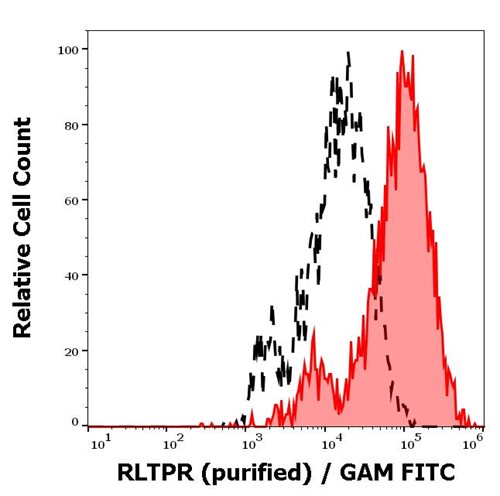Anti-RLTPR / CARMIL2 Monoclonal Antibody (Clone:EM-53)

Figure 1: Separation of RLTPR transfected cells stained using anti-human RLTPR (EM-53) purified antibody (red-filled) from RLTPR transfected cells stained using mouse IgG1 isotype control (MOPC-21) purified antibody (black-dashed) in flow cytometry analysis (intracellular staining).
Roll over image to zoom in
Shipping Info:
For estimated delivery dates, please contact us at support@abeomics.com
| Format : | Purified |
| Amount : | 0.1 mg |
| Isotype : | Mouse IgG1 |
| Purification : | Purified from hybridoma culture supernatant by protein-A affinity chromatography. |
| Storage condition : | Store at 2-8°C. Do not freeze. |
RLTPR / CARMIL2 (RGD motif, leucine rich repeats, tropomodulin domain and proline-rich containing; capping protein regulator and myosin 1 linker 2), also known as LRRC16C, is a cytosolic protein, which with high affinity binds CAPZA2 (capping protein muscle actin Z-line alpha 2) and decreases CAPZA2 affinity for actin barbed ends. RLTPR / CARMIL2 increases the rate of actin filament elongation from seeds in the presence of CAPZA2, however, seems unable to nucleate filaments. Its interaction with CAPZA2 is essential for lamellipodial protrusion and cell translocation. RLTPR / CARMIL2 is crutial for T cell costimulation via CD28 and this property seems to be independent on its actin-uncapping function. The lack of functional RLTPR / CARMIL2 molecules impeded the differentiation toward Th1 and Th17 fates of both human and murine CD4+ T cells and leads to combined immunodeficiency. Expression of RLTPR / CARMIL2 was also detected in human and murine B cells, but it seems not to be involved in BCR-mediated signaling.
| Subcellular location: | Cytoplasm, Cytoplasm, Cell membrane, Cell projection, Cell projection |
| Tissue Specificity: | Expressed in all tissues tested, including thymus, spleen, colon, leukocytes, peripheral blood, skin, skin keratinocytes and skin fibroblasts. Strong expression is detected in naive and memory CD4+ and CD8+ T cells, naive and memory B cells, regulatory T cells and NK cells, whereas it is poorly expressed in monocytes (PubMed:27647349). |
| BioGrid: | 126970. 5 interactions. |
|
There are currently no product reviews
|












.png)












